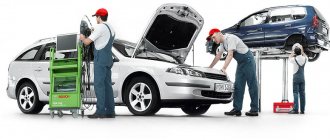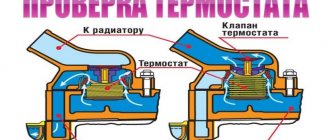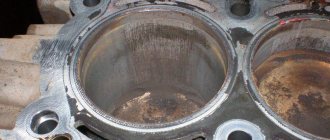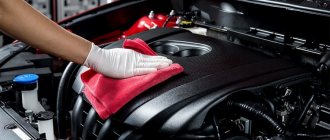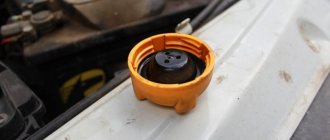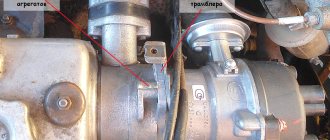The engine is the main part in a car. This is the heart of the car, which, in fact, makes it go. The engine is expensive. Even contract engines for budget cars can cost hundreds of thousands of rubles, which sometimes exceeds the cost of the used car itself.
The price of the engine is at least 70 percent of the cost of the car, so checking the car's engine is the main step before buying a used car. The check is performed in several ways, and you can find out not only about the condition of the engine, but also its number. With the help of technology it is easy to calculate even the real power of the unit.
There are a number of ways to check the engine of a car before purchasing, and today we will look at them in detail.
Self check
A method for those who understand cars and can determine the condition of the engine themselves. If you decide to check the car engine yourself, then start by opening the hood of the car.
When checking yourself you need:
- Inspect the engine itself for leaks, foreign liquids and deformation of the housing from impact. After this, the presence or absence of some common problems, such as damage from external impact (frontal impact) or oil leaks, will become obvious. If the engine under the hood of a used car is dusty and dirty, then you are in luck: a clean and washed engine does not show any leaks of oil or other liquids. You should inspect the engine for leaks during daylight hours and with a flashlight, in other words, with maximum illumination of the engine compartment. If the engine has recently been washed, then all that remains is to ask a question about oil leaks, counting on the seller’s honesty, otherwise such a defect will be identified over time after purchasing the car, and this will become an unpleasant surprise.
- While you are near the running car, you can check the sound of the car's engine. It should operate smoothly, without changes in sound and without making the sound louder or quieter without pressing the pedals. It is worth remembering that the sound of a diesel engine is different from the sound of a gasoline engine - it “rumbles” like a tractor, while a gasoline engine operates in the same key. The sound of boxer engines, which are found on some sports cars, for example, on the entire Subaru line, is also different - these engines “growl” even at idle.
- Take a ride in a car. In fact, the only way to see the engine “in action” is the ability to independently evaluate the power and response to the pedal, to understand whether everything is working as it should, and whether the car is losing power, whether there are any “dips” when driving, and so on.
- Inspect the engine compartment and find out if the car has had a frontal impact. If you can see that the front end of the car has been recovering from a severe accident, it is worth considering that this may affect the performance of the engine in the future.
- Connect the diagnostic wire - if you have such equipment, you can read the error logs of the on-board computer and find out for sure what problems the engine has. But be careful – sometimes unscrupulous sellers use technology to erase errors from the computer’s memory.
If you have a diagnostic wire and you are checking a foreign car that is not too old, then connect a laptop through it and read the errors recorded by the on-board computer. In modern cars, the computer reads errors and saves them in a log, which can always be viewed using the appropriate equipment, which is simple and inexpensive: you only need an OBD cable, a laptop and software for your car brand.
If you are unlucky and come across a “dead” car, the computer will generate a bunch of errors, including engine errors. Next, you simply compare the error numbers with the database and get information about what exactly is wrong, and there can be a huge variety of different defects: from malfunctioning engine mounts, leading to vibrations in the cabin, to missing ignition coils or scuffing in the cylinders.
We conduct a test drive upon purchase
When choosing used cars, you should conduct the most detailed test drive, including checking the engine. It is necessary to evaluate the dynamics of the car, the absence of power failures and any extraneous sounds when accelerating and driving at a constant speed. It is necessary to carry out such a test drive with the window open and closed, which will allow you to hear all the extraneous sounds and knocks in the engine. Only after such detailed diagnostics can you decide to buy a new car.
Conclusion
A high-quality and most detailed check and diagnostics of a used car engine upon purchase will allow you to subsequently avoid any difficulties with the power unit, and you will be spared unexpected costs for car repairs. You can perform such diagnostics either at specialized services that use appropriate computer equipment for diagnostics, or independently, through a detailed inspection of the engine, which will help you identify existing faults and make the right decision on the advisability of purchasing.
The engine is the main part in a car. This is the heart of the car, which, in fact, makes it go. The engine is expensive. Even contract engines for budget cars can cost hundreds of thousands of rubles, which sometimes exceeds the cost of the used car itself.
The price of the engine is at least 70 percent of the cost of the car, so checking the car's engine is the main step before buying a used car. The check is performed in several ways, and you can find out not only about the condition of the engine, but also its number. With the help of technology it is easy to calculate even the real power of the unit.
There are a number of ways to check the engine of a car before purchasing, and today we will look at them in detail.
Checking at a car service center
A surefire way to learn everything about a car and its engine if you don't consider yourself a good expert to inspect it yourself. For a reasonable fee, service specialists will inspect the car completely, consider it a computer (if the car has a diagnostic connector), check all the technical components of the car and even find out whether there has been interference in the memory of the on-board computer, whether the mileage has been changed through it and whether errors have been erased.
It is better to contact either official dealers or specialized centers that work with one brand of car, or with a narrow range of car brands. As a rule, such services know better all the typical “sores” of cars and are very well versed in the engines presented on the brand’s models.
In this case, you only need to choose a service that has a large number of positive reviews and a long history of work, pay for the service and wait until the diagnostics are completed, after which you will be given a work order. Whether you buy a car after that and pay for spare parts and repairs, or hand over the document to the seller and refuse to buy the car, is up to you. This method of checking a car engine is very effective and, as a rule, error-free - if the car is faulty or requires significant investment, specialists will report this based on the diagnostic results.
Advantages of using a car service:
- You will know for sure all the ins and outs of the car and its components: they will tell you whether the car’s mileage was low, whether there were any accidents, what exactly needs to be replaced or repaired at a given time, etc.
- They will issue an order on the spot and tell you where to purchase spare parts and consumables. If you purchase a car right on the spot, you can begin to work on fixing problems without going anywhere.
Disadvantages of working with a car dealership:
- It is necessary to pay for the services of a specialized service; prices vary depending on the region and the qualifications of the servicemen. On average, for services specializing in foreign cars, one standard hour is estimated at 900 to 2000 rubles, diagnostics last an hour and a half, these costs are borne by the potential buyer.
- You will have to spend time on the road to the service, diagnosing the car and then on the way home, you also need to agree on a time that is convenient for all parties: you, the seller and the car service center. Due to the complexity of the organization, the process can take weeks.
- If you choose an inexpensive service “behind garages,” there is a risk that the diagnostics will not be carried out efficiently, which will result in additional expenses for you after purchasing the car.
If you have enough time and are willing to spend several thousand rubles to definitely avoid mistakes, then the service is your option. But be careful when choosing the service itself; saving here is not the best way; it is better to spend more money on the services of high-level specialists.
On-site vehicle diagnostics
The service has come into use recently, but has managed to spread widely and attract a huge number of specialists. Today, anyone can order a car inspection at home; it’s practically the same as a car service, only specialists come to you, and not you to them.
As a rule, the inspection is carried out by automobile experts who work either as mechanics in a car service center or as specialists in the sale of used cars. With a trained eye, they will determine the condition of the car, conduct diagnostics through the on-board computer and tell you exactly what this car has experienced in the past, and what you should be wary of in the future.
The advantage over the service is that you do not need to go anywhere, and the check will be carried out faster, however, the weakness of field specialists remains the lack of complex equipment present in car services, such as a lift. However, if you have a garage with a pit, this problem is leveled out.
Pros:
- Specialists will come to you with a set of necessary equipment and inspect the car. The work takes from 40 minutes to one hour.
- As a rule, on-site diagnostic specialists have carried out a similar procedure many times already, and with a trained eye they can quickly and accurately determine what exactly is wrong with the car. The quality of diagnostics and the “verdict” of field experts are usually very accurate.
- Experts in car selection also negotiate with the seller for you, and you can “bring down” the price of a car you are interested in in good condition. Despite the fact that the price for such services is high, it is usually less than the amount that car selectors manage to negotiate for, and as a result, everyone benefits.
Minuses:
- Lack of some professional equipment present in the car service.
- There is a risk of encountering amateurs who incorrectly assess the condition of the car.
Engine starting
So, friends, we continue to check the engine and our next step will be to start it. Be sure to leave the car turned off for at least ten minutes before starting, and ideally, the engine should be completely cool.
Put the seller or your assistant behind the wheel and watch the exhaust pipe yourself. If at the moment of start-up a cloud of bluish smoke flies out of the muffler, this is not very good. This means that the valve stem seals allow oil to pass through and during parking it flows into the combustion chamber. In principle, this is not a disaster and you can drive like this for quite a long time. But I would recommend that you still look for a car with an engine in perfect condition.
Additionally, at the time of startup, you can place a sheet of paper or a gloved hand under the exhaust. If a black oil spit comes out of the pipe when you start the engine, it means the engine is already pretty worn out. In addition, after a couple of minutes of warming up, a black spot may form under the exhaust pipe. With such a worn out engine, I don’t advise you to buy a car.
